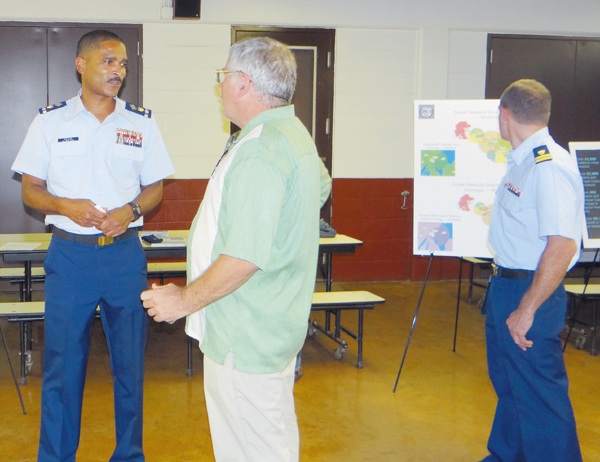LIHUE — The construction of a Rescue 21 radio antenna at Kalepa to aid the U.S. Coast Guard in pinpointing locations of distressed boaters would complete an 11-year project. Members of the Coast Guard and project specialists held an open
LIHUE — The construction of a Rescue 21 radio antenna at Kalepa to aid the U.S. Coast Guard in pinpointing locations of distressed boaters would complete an 11-year project.
Members of the Coast Guard and project specialists held an open house Wednesday at Kauai High School. The goal is to gather input on a draft Environmental Assessment by the September deadline and break ground in November.
Rescue 21 replaces the 40-year-old National Distress and Response System and would provide more specific location information for distress calls. The towers offer bearing triangulation to the source of VHF radio transmissions.
“We’ve been talking about this for years and have been wishing and praying for it,” said Jim Jung, a volunteer recreational boating inspector with the Coast Guard Auxiliary. “This takes a lot of the ‘search’ out of search and rescue.”
Kauai Coast Guard Auxiliary Flotilla Commander Larry Richardson said the new technology will be incorporated into mandatory boater education classes set to begin next year. They are pleased he said to see an essential coverage gap now filled between Kauai and Oahu.
A Rescue 21 site in Kokee is already in operation. Together with the Kalepa site, they would provide boating data to the Coast Guard Sector Honolulu Area of Responsibility. It is transmitted through the Coast Guard Secure Network by satellite and a primary land line backup.
“Before Rescue 21 came along we didn’t have the ability to get a line of bearing from someone from the tower to someone who is on the radio to show they are in that direction,” Lt. Jake Paarlberg of Honolulu. “Where two towers cross we know exactly where they are at and can send an asset to them.”
The Kalepa tower would be a 68-foot tall monopole that reaches 80 feet with a direction finding antenna on top. There is also an equipment shelter, backup generator and diesel fuel tank on site.
Chief Warrant Officer 03 David Wilson is the regional manager of the Rescue 21 program in Arizona. He works with communities around the country to get the towers in place.
Rescue 21 is well-received because of its mission to save lives at sea, he said. The hurdles are to address the environmental issues that come with remote locations.
“We work through those issues and try to accommodate and mitigate the concerns of the local people,” Wilson said.
The Hawaii tower projects started in 2007, and after nearly a decade of deployments, the Kalepa tower is the last leg. The site has taken more work than others because it does not qualify for an exclusion from the environmental assessment.
The natural resources issues, bird paths and burial findings in the area required the full process, Wilson said. Of nine possible sites on Kauai, the Kalepa location proved ideal for operations and in minimizing the environmental impact.
“We are going to do as little disruption to the area as we can,” Wilson said.
The Rescue 21 Kalepa site would be adjacent to an existing structure and a microwave antenna on property leased from Alltel Wireless. A monopole design reduces height to mitigate the number of possible bird strikes and presents little electrical danger from 100 watt radio signals.
“You’re looking at the width of the bird, the number of flights through the area, and the width of the object they have the potential to strike,” said Dennis Mead, an environmental protection specialist with Civil Engineering in Honolulu.
To put this in context, Mead said the Kalepa site presents a six-bird strike potential over 20 years. This compares to as many as 40-bird strike predictions at other proposed locations.
Archaeologists dug a series of 23 test pits and didn’t find anything, he said. However, there were discoveries during construction of the existing Alltel site, so archeologists will be in place during all new construction.
John Burleson, a program manager of General Dynamics, said they have two field service engineers in Hawaii who will maintain the nine sites on all island. The site is at the end of a two-mile road from Hanamaulu.
Stu Burley, a local volunteer and board member with Kauai Island Utility Cooperative, attended the meeting and recommended better security for the Rescue 21 site. There is too much vandalism on the island and the site would be more secure with a razor wire fence, he said.
Lt. Paarlberg said the Coast Guard urges boaters in distress to use their radios rather than cell phones. A phone call would not allow nearby boaters to hear the call for help.
“The best methods for boaters on the water is first to have a VHF nautical radio with the international hailing and distress channel 16,” Paarlberg said.
To send comments on the environmental assessment email sherrill.e.thompson@uscg.mil or call 202-475-3175.


